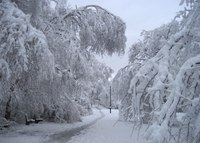Prairie Fare: Stay Safe and Healthy During Extreme Cold
(Click an image below to view a high-resolution image that can be downloaded)
By Julie Garden-Robinson, Food and Nutrition Specialist
NDSU Extension Service
“The roads are really greasy today. Be sure to allow plenty of extra time to get to work this morning,” the weather announcer said.
I looked bleary-eyed at my alarm clock and saw that it was 5 a.m. I must have fallen asleep watching TV, then the station went off the air and came back on at 5 a.m.
Several inches of snow had fallen overnight, resulting in treacherous driving. Yes, winter had swiftly appeared after an unseasonably warm autumn.
Well-bundled TV reporters cautioned our awakening city as they traveled the slick streets. I did not want to leave my cozy spot and venture into our frozen land. I wanted to pull my soft, fluffy comforter over my head and hibernate for a few months.
Then I heard the sound of the snow blower outside the window. My husband was plowing our driveway. I felt a little guilty for not helping, but I fell asleep. My radio/alarm clock went off at 6 a.m. with more dire warnings about driving slowly on the icy roads. Our TV was still on, so I was getting warnings in stereo.
I finally dragged myself out of bed and then attempted to motivate our kids to get ready for school. Yes, we needed to leave early.
I live in Fargo, which has the reputation for extreme cold, thick coats, caps with ear flaps and unusual accents. Uff da! We really do not talk like the people in the movie.
Most of us may grumble awhile when the snow piles are deep and the days are short. We all need to be prepared for cold temperatures outdoors and power failures that may affect our indoor temperatures.
On the way to work, I came upon at least two car wrecks. I decided to review the Centers for Disease Control and Prevention’s “Extreme Cold” guide to prepare myself for the upcoming months. Try this quiz to see if you can answer these questions.
Question 1. Which of the following groups of people are particularly vulnerable to extreme cold? (Choose any that apply)
A: Elderly people with inadequate food, clothing or heating
B: People who are outdoors a long time, including the homeless
C: People who drink alcohol or use illicit drugs
D: Infants in cold rooms or without proper clothing
Questions 2. Which two of the following are the most likely to warm you?
A: Hot coffee
B: Hot tea
C: A beverage containing alcohol
D: Hot cocoa
E: Warm broth
Question 3. What is the name given to an abnormally low body temperature? Name at least two potential causes of this condition.
Question 4. What should you do if you suspect your feet or toes have frostbite?
A: Get into a warm area.
B: Immerse your feet in warm water.
C: Avoid walking.
D: Avoid using a heating pad or the heat of a stove or fireplace for warming your feet.
E: All of the above are correct.
Question 5. List at least five items you should keep in your vehicle to be prepared for a breakdown in extremely cold weather.
The answers are:
- All of these groups are vulnerable to extreme cold.
- D and E - A warm, sweet beverage or a cup of broth-based soup, such as chicken noodle, will warm you faster than caffeinated or alcohol-containing beverages. Your body also needs the calories to maintain your temperature.
- Hypothermia is an abnormally low body temperature, and it might be caused by cold temperatures or cool temperatures (40 degrees or lower), particularly when a person gets wet from falling into cold water, or from rain or sweat.
- E - All of these are the CDC’s recommendations.
- Be sure you have your winter survival kit in your vehicle. The kit should include blankets, booster cables, tow rope, shovel, high-calorie dried or canned food (and a can opener), a container of water, a can and matches (to melt snow for additional water), a flashlight, batteries and several other items on the “Extreme Cold” list (available at http://emergency.cdc.gov/disasters/winter/guide.asp).
Stay warm and well this winter. When the morning news makes you want to stay tucked in your cozy bed, here’s a tasty, warm beverage mix that might entice you to heat some water. See “Beverage Mixes in a Jar” (available at http://tinyurl.com/beveragemixes).
French Vanilla Coffee Mix
1/3 c. instant coffee (regular or decaffeinated)
1 c. instant skim milk powder
1/2 c. powdered nondairy coffee creamer
1/3 c. white sugar
1/4 c. French vanilla instant pudding mix
Add the ingredients to a food processor. Pulse until thoroughly mixed and you have a smooth powder. Store mixture in an airtight, pint-size glass or plastic container. For each serving, place 3/4 cup of boiling water in a mug and stir in 2 heaping teaspoons of mix.
Makes 16 servings. Each serving has 50 calories, 1 gram (g) fat, 2 g protein, 10 g carbohydrate, 0 g fiber and 65 milligrams sodium.
(Julie Garden-Robinson, Ph.D., R.D., L.R.D., is a North Dakota State University Extension Service food and nutrition specialist and professor in the Department of Health, Nutrition and Exercise Sciences.)
NDSU Agriculture Communication - Dec. 3, 2015
| Source: | Julie Garden-Robinson, (701) 231-7187, julie.garden-robinson@ndsu.edu |
|---|---|
| Editor: | Ellen Crawford, (701) 231-5391, ellen.crawford@ndsu.edu |



